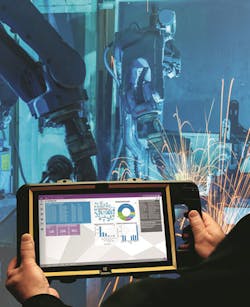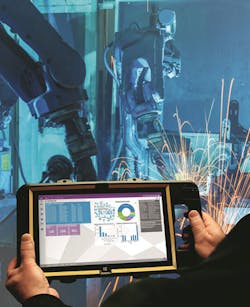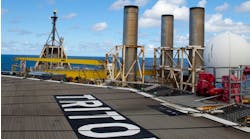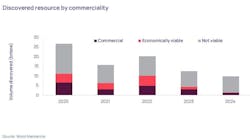Patrick Zirnhelt
IFS North America
Rig moves are vulnerable times for offshore drillers. Striking a balance between keeping a cap on costs, managing data transfer and remaining safe and compliant in various jurisdictions is a difficult challenge.
The task of managing the reassignment of a rig from one company to another, or one place to another, falls to the CFO and financial department. Fortunately, advances in the Internet-of-Things (IoT) are improving real-time asset visibility across the rig and, with the right support, can make this job easier - at every stage of the move.
Songa Offshore recently selected IFS Applications to further advance its maintenance efficiency and operationalize IoT data onboard its drilling rigs. Through implementing the IFS IoT Business Connector, its assets are able to transmit condition readings to IFS Applications, which then form a basis for planning and optimizing maintenance activities across its fleet of rigs.
With increased process automation, Songa Offshore now benefits from enhanced asset reliability, longer times between service intervals, longer asset lifespans, and cost savings. Songa Offshore is now live with the solution, with 600 asset sensors per rig. The next step will be to increase the scope of IFS IoT Business Connector to connect even more of the 5,000 maintenance asset sensors located on each rig - including retrofitting sensors onto existing equipment to further improve reliability.
There are four steps organizations must take to ensure their rig move is a success. These are examined below.
Preparation. Before moving a multi-million-dollar vessel, a process should be implemented to document the current status of the rig and all the operational processes involved - whether offshore contractors are moving it between geographical areas, handing over to another operator or performing major maintenance. Tracking all the details of a site will provide the correct starting point and visibility necessary to remain compliant throughout the entire move process. IoT sensor data will provide essential information for this part of the operation.
The right project-based solution should help from planning phase to the start of the move, through transportation and final sign off at a new geographical site - all within a single solution. In this instance, a site is defined as a logistical unit holding the history of all maintenance performed, as well as all financial transactions and inventory values for a rig or vessel.
By providing full support for traceability of the rig’s lifecycle, organizations can avoid re-classification of the rig and ensure environmental and safety regulations are met. It should also support local tax and accounting regulations in whatever geographical area the rig is based, or will be in the future, while simultaneously ensuring that the move is conducted safely. These local regulations may have implications for how the rig is staffed, which has implications for the number of modular accommodations, the type of maintenance documentation required and in the case where inventory kept in jurisdictional waters is taxed, the number of spares and repairs it makes sense to keep on the rig.
Planning. When processes have been documented, management can then begin to plan and forecast an upcoming move. With proper role-based security, users can easily retrieve queries and reports for internal and external reporting, making managing compliance and real-time visibility far easier. Faster reporting and accurate forecasting is extremely beneficial to drilling contractors, enabling management to rely on up-to-date key performance indicators, financials, environmental impact and operational costs.
When considering all the processes involved in a rig move, accurate forecasting provides an opportunity for drilling contractors to prepare and decide what financial transactions need to remain, be closed or recreated. A solution which can simulate transactions when moving a company from contract to contract provides the foresight organizations need to produce informed plans, as the drilling contractor can evaluate what to do with each transaction in relation to the current rig and company.
Once a scenario has been simulated, contractors can project the right cost, depreciation and value in an upcoming contract before the rig move process begins. Being able to see the impact of moving a rig from one company to another is a benefit of accurate forecasting you get from a single end-to-end, fully integrated solution. The ability to forecast in this manner saves time and money for drilling contractors, critical in the oil and gas industry - now more than ever.
Execution. Once a rig move has begun, drilling contractors require visibility over vast data sets - accounting currencies, work orders, maintenance transactions and more. During the move, management also need to monitor the environmental impact, cost of operations, support for quality assurance and health and safety management.
Unfortunately, many drilling contractors still struggle with their disjointed and unintegrated solutions. None of their existing systems are comprehensive or agile enough to fully map the diverse requirements, processes and extra transactions required on a rig during a move. By bringing together all these data streams into a single solution, drilling contractors can reap the benefits of analyzing large amounts of real-time information - presenting an accurate picture of events and enabling well-informed decision making during the move. Having access to a rig’s complete maintenance history in one solution enables traceability, but also guarantees compliance.
Post-move. From beginning to end, manual transactions pose significant risk to rig moves - causing inaccuracy, delays and spiralling costs. If a drilling contractor begins a rig move with fragmented systems, there is a risk the finance department will see an inaccurate picture of how the move has taken place.
Fragmented systems handling rig move processes may mean it takes the finance department months to recognize a rig has been moved to a new location or even operator. This lack of visibility and delay of information sharing significantly hinders operations, while backtracking to correct data creates unnecessary overhead costs.
The right enterprise software can extract necessary data and then alert users of what objects need to be cancelled, closed and/or transferred from projects to conduct compliant and well-documented rig moves. This functionality enables a much more cohesive transfer of data, improves documentation for finance, optimizes processes and reduces error postings, manual corrections and overall transactions.




